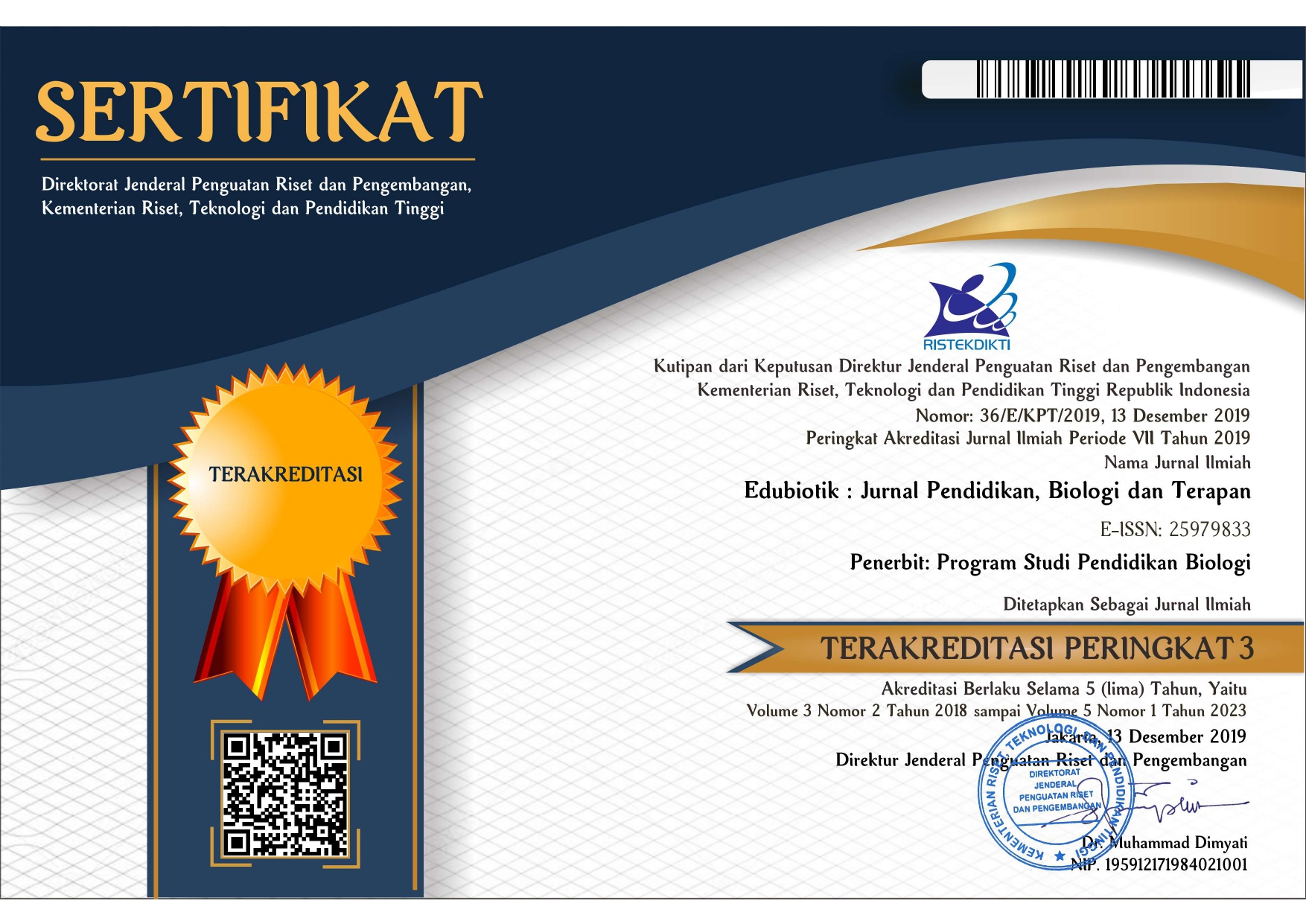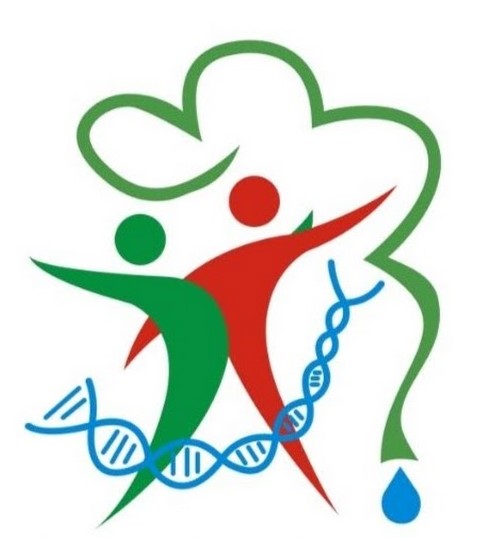Development of android media in invertebrate learning
Abstract
The development of android media for invertebrate material in biology lessons has not been carried out and needs to be optimized. The research aims to develop android media for invertebrate learning. This type of research is research and development using the Plomp and Nieveen development model, which is limited to the prototyping phase, and formative evaluation based on Tessmer which consists of self-evaluation, expert opinion, individual testing, small group testing, and field testing. The research subjects consisted of 3 experts and 30 students who had programmed the Invertebrates course for individual tests, small group tests, and field tests. The research instruments include validation sheets and essay-based tests. The acquired data was subjected to descriptive analysis. The validation of Android media shows that the media is suitable for use with an average of 72, practicality testing shows the ease of the learning process with an average of 94, effectiveness testing before using Android media is 32 and after using Android media is 87. The conclusion is that the Android media developed is valid, practical, and effective and can be used for the learning process. Furthermore, tests can be carried out on a wider scale to obtain more homogeneous data.
References
Astuti, I. A. D., Sumarni, R. A., & Saraswati, D. L. (2017). Pengembangan media pembelajaran fisika mobile learning berbasis android. Jurnal Penelitian & Pengembangan Pendidikan Fisika, 3(1), 57–62. https://doi.org/10.21009/1.03108
Bradley, L., Bartram, L., Al-Sabbagh, K. W., & Algers, A. (2023). Designing mobile language learning with Arabic speaking migrants. Interactive Learning Environments, 31(1), 514–526. https://doi.org/10.1080/10494820.2020.1799022
Branchais, S., & Achmadi, H. R. (2019). Validitas media pembelajaran interaktif berbasis android pada materi gejala pemanasan global kelas XI SMA. Inovasi Pendidikan Fisika, 8(2), 508–511. https://ejournal.unesa.ac.id/index.php/inovasi-pendidikan-fisika/article/view/27362
Chaka, J. G., & Govender, I. (2020). Implementation of mobile learning using a social network platform: facebook. Problems of Education in the 21st Century, 78(1), 24–47. https://doi.org/10.33225/pec/20.78.24
Deadara, E., Suyanto, S., & Ciptono, C. (2017). Pengembangan media pembelajaran sistem reproduksi manusia berbasis android untuk meningkatkan pemahaman konsep peserta didik. Jurnal Edukasi Biologi, 6(4), 198–210. https://journal.student.uny.ac.id/ojs/index.php/jeb/article/view/8104/7711
Dewy, M. S., Ganefri, G.S., & Kusumaningrum, I. (2016). Pengembangan model pembelajaran berbasis produk pada mata kuliah praktek elektronika daya. Jurnal Ilmiah Pendidikan Teknik Elektro, 1(1), 15–28. https://jurnal.untirta.ac.id/index.php/VOLT/article/view/806
Erikson, M. G., & Erikson, M. (2019). Learning outcomes and critical thinking–good intentions in conflict. Studies in Higher Education, 44(12), 2293–2303. https://doi.org/10.1080/03075079.2018.1486813
Firmansyah, F. E., & Ambarwati, R. (2018). Pengembangan media berbasis android rumah siput pada materi mollusca untuk sma kelas X. BioEdu: Berkala Ilmiah Pendidikan Biologi, 7(2), 313–320. https://ejournal.unesa.ac.id/index.php/bioedu/article/view/28788/26358
Fisher, A. 2014. Berpikir Kritis: Sebuah Pengantar. Jakarta: Erlangga
Fransisca, M. (2017). Pengujian validitas, praktikalitas, dan efektivitas media e-learning di sekolah menengah kejuruan. Jurnal Ilmiah Pendidikan Teknik Elektro, 2(1), 17–22. https://jurnal.untirta.ac.id/index.php/VOLT/article/view/1091
Halpern, D. F. (2013). Thought and Knowledge: An Introduction to Critical Thinking (5th ed.) (5th Edition). Psychology Press. https://doi.org/https://doi.org/10.4324/9781315885278
Han, I., & Shin, W. S. (2016). The use of a mobile learning management system and academic achievement of online students. Computers and Education, 102, 79–89. https://doi.org/10.1016/j.compedu.2016.07.003
Handoyono, N. A., & Mahmud, A. (2020). Pengembangan media pembelajaran berbasis android pada pembelajaran electronic fuel injection. INVOTEK: Jurnal Inovasi Vokasional dan Teknologi, 20(2), 107–116. https://doi.org/10.24036/invotek.v20i2.791
Jusniar, Side, S., & Muh. Anwar. (2014). pengembangan perangkat assesment berbasis keterampilan generik sains (kgs) pada mata kuliah praktikum kimia fisik ii. Jurnal Penelitian Pendidikan Kimia, 1(1), 35–42. https://ejournal.unsri.ac.id/index.php/jurpenkim/article/view/2382/1256
Kankam, P. K. (2020). Mobile information behaviour of sandwich students towards mobile learning integration at the University of Ghana. Cogent Education, 7(1), 1–14. https://doi.org/10.1080/2331186X.2020.1796202
Khuzaini, N., & Sulistyo, T. Y. (2020). Pengembangan media pembelajaran interaktif berbasis android menggunakan adobe flash CS6 pada materi segiempat dan segitiga. KoPeN, 2(1), 178–183. http://ejurnal.mercubuana-yogya.ac.id/index.php/Prosiding_KoPeN/article/view/1097
Kleemola, K., Hyytinen, H., & Toom, A. (2022). Critical thinking and writing in transition to higher education in Finland: Do prior academic performance and socioeconomic background matter?. European Journal of Higher Education, 13(4), 488-508. https://doi.org/10.1080/21568235.2022.2075417
Kusmayadi, K., Suyitno, I., & Maryaeni, M. (2017). Pengembangan multimedia cerita rakyat sebagai penumbuhan karakter siswa. Jurnal Pendidikan: Teori, Penelitian, Dan Pengembangan, 2(7), 902–909. http://journal.um.ac.id/index.php/jptpp/article/view/9630
Lee, J., Choi, H., Davis, R. O., & Henning, M. A. (2023). Instructional media selection principles for online medical education and emerging models for the new normal. Medical Teacher, 45(6), 633-641. https://doi.org/10.1080/0142159X.2022.2151884
Mahmuzah, R. (2015). Peningkatan kemampuan berpikir kritis matematis siswa smp melalui pendekatan problem posing. Jurnal Peluang, 4(1). https://jurnal.usk.ac.id/peluang/article/view/5860
May, C. J., Wittingslow, R., & Blandhol, M. (2022). Provoking thought: A predictive processing account of critical thinking and the effects of education. Educational Philosophy and Theory, 54(14), 2458–2468. https://doi.org/10.1080/00131857.2021.2006056
Muyaroah, S., & Fajartia, M. (2017). Pengembangan media pembelajaran berbasis android dengan menggunakan aplikasi adobe flash cs 6 pada mata pelajaran biologi. Innovative Journal of Curriculum and Educational Technology, 6(2), 22–26. https://journal.unnes.ac.id/sju/index.php/ujet/article/view/19336
Noprianda, M., Noor, M. F., & Zulfiani, Z. (2016). Keterampilan berpikir kritis siswa model pembelajaran problem based learning dan sains teknologi masyarakat pada konsep virus. EDUSAINS, 8(2), 182–191. https://doi.org/10.15408/es.v8i2.3892
Nurbaiti, Panjaitan, R.G. P., & Titin. (2017). The properness of adobe flash basis interactive media for respiratory system learning material. Unnes Science Education Journal, 6(3), 1662–1668. https://journal.unnes.ac.id/sju/index.php/usej/article/view/20350
Nugroho, B.A. (2023). Mobile learning environment system: pengembangan media android dari perspektif validitas. Biopedagogia, 5(1), 26-36. http://jurnal.borneo.ac.id/index.php/biopedagogia/article/view/3525
Nygren, T., Haglund, J., Samuelsson, C. R., Af Geijerstam, Å., & Prytz, J. (2019). Critical thinking in national tests across four subjects in Swedish compulsory school. Education Inquiry, 10(1), 56–75. https://doi.org/10.1080/20004508.2018.1475200
Ojeda, I. C., Vanegas, E., Felix, M., Mata, V. L., Jiménez, F. M., Sanchez, M., Simancas-Racines, D., Cherrez, S., Gavilanes, A. W. D., Eschrich, J., & Chedraui, P. (2020). Frequency of use, perceptions and barriers of information and communication technologies among latin american physicians: An ecuadorian cross-sectional study. Journal of Multidisciplinary Healthcare, 13, 259–269. https://doi.org/10.2147/JMDH.S246253
Panjaitan, R.G.P., Titin, T., & Putri, N.N. (2020). Multimedia interaktif berbasis game edukasi sebagai media pembelajaran materi sistem pernapasan di kelas XI SMA. Jurnal Pendidikan Sains Indonesia (Indonesian Journal of Science Education), 8(1), 141–151. https://jurnal.usk.ac.id/JPSI/article/view/16062
Pramita, A. (2016). Pengembangan media permainan ular tangga pada materi senyawa hidrokarbon kelas XI SMA untuk meningkatkan pemahaman konsep siswa. Journal of Chemical Education, 5(2), 336–344. https://ejournal.unesa.ac.id/index.php/journal-of-chemical-education/article/view/15787
Purnama, R. B., Sesunan, F., & Ertikanto, C. (2017). Pengembangan media pembelajaran mobile learning berbasis android sebagai suplemen pembelajaran fisika SMA pada materi usaha dan energi. Jurnal Pembelajaran Fisika, 5(4), 63–74. http://jurnal.fkip.unila.ac.id/index.php/JPF/article/view/13650
Purwantoro, S., Rahmawati, H., & Tharmizi, A. (2013). Mobile searching objek wisata Pekanbaru menggunakan location base service (lbs) berbasis android. Jurnal Politeknik Caltex Riau, 1(14), 176-184. http://www.pdii.lipi.go.id/wpcontent/uploads/2014/03/Seminar -Nasional-Infonnatika-_SNlf-2013
Putra, D. P. (2021). Pengembangan media pembelajaran fisika menggunakan kartun 3D. Jurnal Literasi Digital, 1(2), 88-93. https://www.researchgate.net/
Rahman, F. R., Soendjoto, M. A., & Dharmono, D. (2017). Validitas media pembelajaran interaktif keanekaragaman jenis burung di Panjaratan pada konsep keanekaragaman hayati SMA/MA. Prosiding Seminar Nasional Lahan Basah Tahun 2016, 2, 689–694. https://www.researchgate.net/
Saleh, N. F., & Jalambo, M. O. (2022). Female students’ perception of m-learning in the higher education institutions of Palestine during the COVID-19 pandemic. Cogent Education, 9(1), 1–16. https://doi.org/10.1080/2331186X.2022.2147775
Sari, S., Anjani, R., Farida, I., & Ramdhani, M. A. (2017). Using android-based educational game for learning colloid material. International Conference on Mathematics and Science Education (ICMScE), 895(1), 1–6. https://doi.org/10.1088/1742-6596/895/1/012012
Surahman, E., & Surjono, H. D. (2017). Pengembangan adaptive mobile learning pada mata pelajaran biologi sma sebagai upaya mendukung proses blended learning. Jurnal Inovasi Teknologi Pendidikan, 4(1), 26–37. http://dx.doi.org/10.21831/jitp.v4i1.9723
Turkmen, H., & Sertkahya, M. (2015). Creative thinking skills analyzes of vocational high school students. Journal of Educational and Instructional Studies in The World, 5(1), 2146–7463. https://citeseerx.ist.psu.edu/document?repid=rep1&type=pdf&doi=0460dc1683918fb9954f28b53fc825330318fd8e
Wang, Y.-Y., Wang, Y.-S., Lin, H.-H., & Tsai, T.-H. (2019). Developing and validating a model for assessing paid mobile learning app success. Interactive Learning Environments, 27(4), 458–477. https://doi.org/10.1080/10494820.2018.1484773
Wilson, M., & Bolliger, D. U. (2013). Mobile learning: endless possibilities for allied health educators. Journal of Diagnostic Medical Sonography, 29(5), 220–224. https://doi.org/10.1177/8756479313503734
Zaini, M. (2019). Effectiveness of students’ worksheet on the madrasah students’ Biological conceptual understanding (an educational design research). BIOEDUKASI: Jurnal Pendidikan Biologi, 12(1), 20–29. https://jurnal.uns.ac.id/bioedukasi/article/view/27384





.png)
2.png)

1.jpg)


